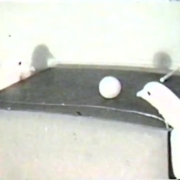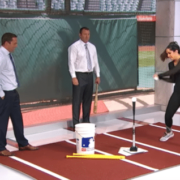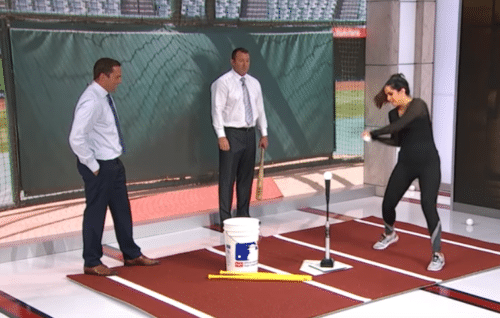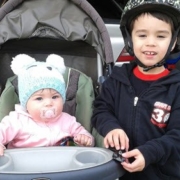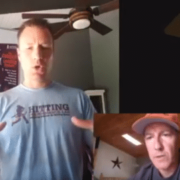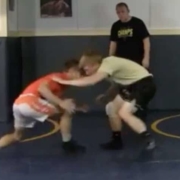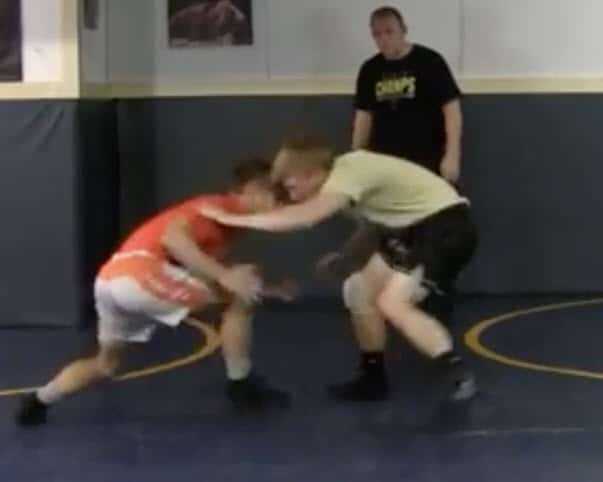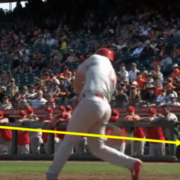Discover the science of successful learning behind how to teach beginner youth 4, 6, 8, 9, and 10 year olds to hit a baseball or softball. Learn the principles of how to teach fun hitting drills to help a struggling hitter improve their power.
How To Train A 2-Year-Old To Hit A Moving Ball
This is a follow up to the post I recently published titled, “WHY ‘Squishing The Bug’ Is So Dumb”.
I had a couple coaches reach out over email and social media,
Saying although they agreed with not teaching older hitters to ‘squish the bug’, they disagreed that it’s okay to teach younger hitters.
Let me be clear, I don’t typically get into weight transfer with hitters less than 7-years-old. HOWEVER, it can be done, and that’s what this post is all about.
So, is it the young hitter that’s incapable of learning how to do what the best do?
OR…
Is the instructor incapable of teaching what the best do?
The answer will become clear in following.
We’ll discuss:
- What science of learning says, and
- Regression to progression models for teaching.
SCIENCE-BASED TRAINING:
Improve your hitting strategy dramatically by applying human movement principles.
Learn not only how and what to train but also the science behind the methods.
What Science of Learning Says…
One Facebook reader shared that he has 12-years in the child development field, in addition to having 8-years of coaching at different levels.
He agreed with the aforementioned ‘squishing bugs is dumb’ post, but said what he’s seen in child development research is that the majority of 6-year-olds are incapable of shifting their weight and hitting a pitched ball. He added that only the top 1% of kids can.
He also referenced a kid with what he called “no athletic” ability as an example.
This is an interesting comment coming from someone with his professional background. And I asked myself, okay, what am I missing because my experience has been much different.
First of all, to reference the bottom 1% of kids in “train-ability” throws up a yellow flag for me (“train-ability” was referenced in the book The Sports Gene: Inside the Science Of Extraordinary Athletic Performance by David Epstein in the Heritage Study).
Since this gentleman is convinced “normal” 6yos can’t be taught to weight shift and hit a ball (exclude mutants and bottom 1% from the equation), then…
I asked if he’d read The Talent Code: Greatness Isn’t Made. It’s Grown. Here’s How. by Daniel Coyle. And what his thoughts were on Daniel Coyle’s findings of the following athletic “hotbeds”:
- 3yo females learning gymnastics in China?
- 3yo females learning tennis in Russia?
- Young females learning golf in Korea?
- Young boys learning baseball in Curacao?
- Young boys learning soccer in Brazil?
He responded with, well it’s different in Russia because they’re more disciplined.
Wa??!
I said oh, so if the kids practice, then it’s possible for “normal” athletes?
No response from him on that.
I then went on to talk about how the International Youth & Conditioning Association, which I am a certified member of, shared their own child development research that children between the ages of two to five years old should developmentally be able to run, hop, jump, forward skip, and sideways skip.
Weight shifting, like in a stride, is very similar to side skipping. Think about throwing a Frisbee as far as you can. And, Pitchers do this all the time, in addition to first baseman when stretching to receive a throw from an infielder (okay, this is more of a front step, but you get the idea).
This gentleman said although this may be true, normal kids cannot side step AND hit a moving pitch.
We’ll get into the progression I used with my own boy when he was 2-years-old, at the end of this post. But hey, maybe he’s part of the top 1%…I dunno 😛 lol You be the judge.
Back to the child development expert, I mentioned the following book to him Don’t Shoot The Dog: The New Art Of Teaching And Training, by Karen Pryor, which is about using positive and negative reinforcers in behavioral conditioning. Basically, it’s a dog training book (worst title ever by the way!!), but the info is just as applicable to humans, horses, dolphins, and any other thing that has flippers, 2-4 legs, and breathes air. Also, this is what was used to train the two ping-pong pigeons in the video above.
PIGEONS! I’ve also read somewhere, might have been in the Don’t Shoot The Dog book, that a scientist once taught a chicken to turn the pages of a book…a CHICKEN!!!
Let that sink in for a moment…
Here’s what I took away from the conversation with Mr. Child Development Expert…
The brain and eyes have a contract with each other…the eyes are only suppose to look for what the brain wants to see. You can read about that in the book Stumbling Upon Happiness by Daniel Gilbert.
And this child development expert was biased towards information confirming his belief that “normal” 6yos cannot side step and hit a moving ball.
BREAKING NEWS!!
I’m biased too! But on the opposite side of the spectrum. I operate from the perspective that if the young athlete isn’t getting what I want him or her to do, then I’m NOT doing something right. Not the other way around. I find a way, and look for information validated by science to support my claim.
So which coach would you rather work with?
Let me repeat,
Teaching hitters to ‘squish the bug’ has NOTHING to do with what the best do. And an instructor that defaults to this when teaching young hitters is like a grade school teacher teaching his 1st Grade students that 2 +2 = 5, because they’re incapable of learning that the real answer is 4.
Look, some of you may be thinking that ‘squishing the bug’ is about “getting the hips through”. My good friends Matt Nokes AND Homer Bush dispelled this myth in the following posts:
- Matt Nokes: Why Rotating Back Hip Through Zone IS NOT Necessary For Power, and
- Homer Bush Interview: How To Turn A Pitcher’s Best Weapon Against Them
I was told this is a BOLD statement…to say teaching ‘bug squishing’ is WRONG.
It is wrong.
You may feel I’m judging you, but I’m not. I have an issue with what you’re teaching and WHY. NOT with you.
I think you’re better than that. It’s not personal.
But be honest with yourself. It’s not what the best do, but I do understand you’re frustrated working with these younger hitters.
…And may have a solution…
Regression to Progression Models for Teaching
I’m not going to get into how to teach side stepping in this post. If your kid can side skip, or side step, then they’re fully capable of a weight shift.
The question is how to get them to hit a moving ball.
And before I get there, I wanted to share a quick story I read in Arnold Schwarzenegger’s autobiography Total Recall: My Unbelievably True Life Story, that highlights the learning process.
Remember this scene in the movie Terminator 2…? (video should start there, but watch at about the 5:00 min. mark)…
In the book, Arnold discussed how he learned to load a shotgun with one hand, while riding a Harley Davidson motorcycle, and at the same time shooting the padlock off a chain-link fence.
According to him, this was his process:
- NOTE: He spent time in the Austrian Army as a tank driver in his younger days, so he knew how to shoot a weapon beforehand.
- He spent many repetitions loading this particular shot gun with one hand, seated on the Harley.
- He spent many repetitions loading the shotgun, seated on the Harley, shooting a small target.
- He spent many repetitions loading the shotgun while riding the motorcycle.
- He spent many repetitions loading the shotgun, riding the Harley, and shooting the target.
His whole thing was “reps, reps, reps”, until the action he practiced became second nature.
This is also what Josh Waitzkin calls “making small circles”, in his book The Art Of Learning: A Journey in Pursuit of Excellence. Josh was a young chess prodigy, and his life was the basis for the movie “Searching for Bobby Fischer”.
How did I teach my 2-year-old son how to hit a moving ball? Here’s the process:
- Starting at about 1.5 years old, we practiced hitting different sized balls off a little tee with a big plastic blue bat,
- A few months before he turned two years old, I started throwing a big beach ball at him while he hit it with his big plastic bat,
- We then started slowly shrinking the ball down until after a few months past his second birthday, he was hitting baseball sized whiffle balls with his big plastic bat, and then
- We shrunk the bat down to a conventional yellow whiffle ball bat, so at about 2.5-3 years old, he was able to hit a baseball sized whiffle ball with the slim yellow bat.
Truth be told at 3yo, he wasn’t hitting every pitch I threw at him, but he was hitting the ball harder more often, other than just ‘tipping it’ or totally swinging and missing like most his age or older, who didn’t have the prior progressions.
The Bottom Line…
Coaches,
If 3 year old girls are learning tennis in Russia, golf in Korea, and gymnastics in China, then your hitters can learn how to step sideways and hit a moving ball. If discipline is an issue, use the Minimum Effective Dosage Rule, practice only 4-5 days per week, for only 5-mins each day. It’s not about length of time, but frequency of reviewing the material.
If you can teach a chicken to turn the pages of a book, and train two pigeons to play ping-pong, then YES you can train “normal” kids to step sideways and hit a moving ball.
If you cannot, then the fault most likely falls – I know this may be hard to swallow for some – with the instructor, not the child. Set the ego aside. Every day, ask yourself the question:
“What don’t I know?”

